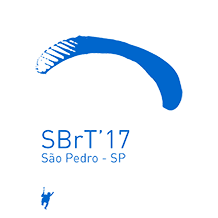
XXXV Simpósio Brasileiro de Telecomunicações e Processamento de Sinais
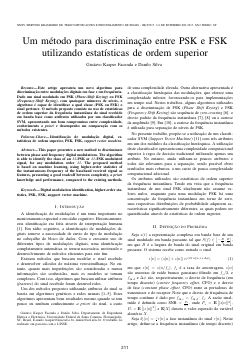
Um método para discriminação entre PSK e FSK utilizando estatísticas de ordem superior
Gustavo Kasper Facenda, Danilo Silva
DOI: 10.14209/sbrt.2017.25
Keywords: Digital modulation identification higher-order statistics PSK FSK support vector machine
Abstract
This paper presentes a new method to discriminate between phase and frequency digital modulations. The algorithm is able to identify the class of an M-PSK or M-FSK modulated signal, for any modulation order M. The proposed method is based on machine learning, using higher-order statistics of the instantaneous frequency of the baseband received signal as features, presenting a good tradeoff between complexity, a priori knowledge and performance, compared to the existing methodsDownload
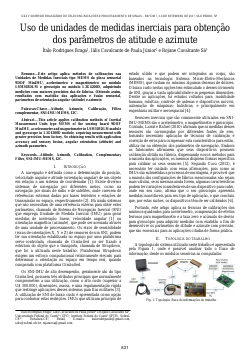
Uso de unidades de medidas inerciais para obtenção dos parâmetros de atitude e azimute
Ítalo Rodrigues Braga¹, Iális Cavalcante de Paula Júnior², Rejane Cavalcante Sá³
DOI: 10.14209/sbrt.2017.26
Keywords: Atitude Azimute Calibração Filtro complementar SNI-IMU-MEMS I2C.
Abstract
Este artigo aplica métodos de calibrações nas Unidades de Medidas Inerciais tipo MEMS da placa sensorial 9DOF MinIMU, acelerômetro e magnetômetro no módulo LSM303DLM e giroscópio no módulo L3G4200D, adquirindo medições com maiores precisões das de fábrica. Obtendo assim, resultados com exatidão das aplicações e fusão sensorial, parâmetros de orientação angular (atitude) e azimute.Download
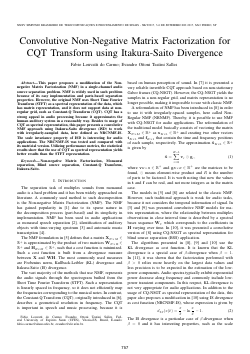
Convolutive Non-Negative Matrix Factorization for CQT Transform using Itakura-Saito Divergence
Fabio Louvatti do Carmo, Evandro Ottoni Teatini Salles
DOI: 10.14209/sbrt.2017.29
Keywords: Non-negative Matrix Factorization Monaural separation Blind source separation Constant-Q Transform Itakura-Saito
Abstract
This paper proposes a modification of the Nonnegative Matrix Factorization (NMF) in a single-channel audio source separation problem. NMF is widely used in such problem because of its easy implementation and parts-based separation properties. However, the original NMF uses Short Time Fourier Transform (STFT) as a spectral representation of the data, which has matrix representation, and it does not support data at nonregular grid, such as Constant-Q Transform (CQT). CQT has a strong appeal in audio processing because it approximates the human auditory system in a reasonably way. Besides to usage of CQT as spectral representation, this paper presents a convolutive NMF approach using Itakura-Saito divergence (ISD) to work with irregularly-sampled data, here defined as NRCNMF-IS. The scale invariance property of ISD is interesting for audio applications. The NRCNMF-IS was tested and compared with its matricial version. Utilizing performance metrics, the statistical results show that the use of CQT as spectral representation yields better results than the STFT representation.Download
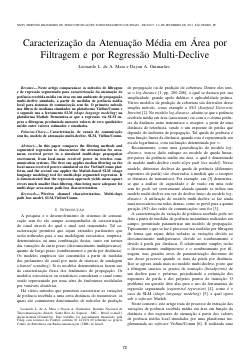
Caracterização da Atenuação Média em Área por Filtragem e por Regressão Multi-Declive
Leonardo L. de A. Maia, Dayan A. Guimarães
DOI: 10.14209/sbrt.2017.30
Keywords: Caracterização de canais de comunicação sem fio modelo de atenuação multi-declive SLM VisSim/Comm.
Abstract
Neste artigo comparam-se os métodos de filtragem e de regressão segmentada para caracterização da atenuação de potência recebida média em área em um ambiente de propagação multi-declive simulado, a partir de medidas de potência média local para sistemas de comunicação sem fio. O primeiro método usa filtros de mediana simulados na plataforma VisSim/Comm e o segundo usa a ferramenta SLM (shape language modeling) na plataforma Matlab. Demonstra-se que a regressão via SLM supera a filtragem, produzindo menores valores de erro quadrático médio entre valores estimados e simulados.Download

Análise de Desempenho de uma Rede Cognitiva Full-Duplex com Captação de Energia
Hebert Douglas Pereira, Samuel B. Mafra, Evelio M. G. Fernandez
DOI: 10.14209/sbrt.2017.31
Keywords: Energy Harvesting cooperative cognitive network full-duplex comunication joint decoding.
Abstract
We investigate the performance of a full-duplex energy harvesting cooperative cognitive network composed by one transmitter and one destination in the primary network, and one source, one relay, and one destination in the secondary network, in which joint decoding of the signals received from source and relay is performed. The effect of self-interference at the relay is taken into account in our analysis due to the fullduplex relaying nature. A closed-form expression for the outage probability of the proposed scheme is derived. Result show that the proposed scheme outperforms the half-duplex and direct transmission in the particular scenarios under consideration.Download

Discovery protocols for SDN-based Wireless Sensor Networks with unidirectional links
Renan C. A. Alves, Cintia B. Margi
DOI: 10.14209/sbrt.2017.32
Keywords: Wireless sensor networks Software defined networks Unidirectional networks Neighbor Discovery
Abstract
Ad hoc and wireless sensor networks routing protocols are usually oblivious to the existence of unidirectional links. We propose to use Software Defined Network to take advantage of these links, instead of using the flooding-based or specificpurpose protocols found in the literature. To achieve this goal, it is necessary to devise Controller Discovery and Neighbor Discovery protocols tailored for unidirectional networks. We designed and implemented such algorithms and compared to the traditional Collect-based approach. The results show that SDN is a promising alternative to routing in unidirectional networks.Download
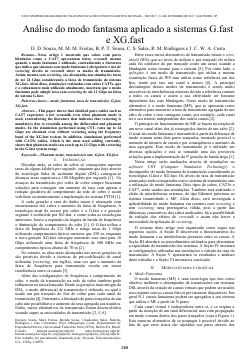
Análise do modo fantasma aplicado a sistemas G.fast e XG.fast
D. D. Souza, M. M. M. Freitas, B. P. T. Sousa, C. S. Sales, R. M. Rodrigues, J. C. W. A. Costa
DOI: 10.14209/sbrt.2017.33
Keywords: modo fantasma taxa de transmissão G.fast XG.fast
Abstract
Nesse artigo é mostrado que cabos com pares blindados como o CAT7 apresentam baixo crosstalk mesmo quando o modo fantasma é utilizado, contradizendo a literatura que indica que sistemas com modo fantasma é obrigatório o uso de vectoring devido ao crosstalk entre os modos de transmissão. Assim, mesmo sem vectoring, são alcançadas nas simulações taxas de até 24 Gbps considerando a faixa de transmissão do sistema XG.fast. Além disso, simulações realizadas com cabos CAT5e, que é o cabeamento mais utilizado atualmente, mostram que o modo fantasma pode atingir taxa com vectoring de até 12 Gbps na faixa do sistema G.fast.Download

Reconhecimento de Células Reprodutoras Masculinas em Imagens de Microscopia sem Lentes
André Brasil Vieira Wyzykowski, Eros Comunello, Antonio Carlos Sobieranski
DOI: 10.14209/sbrt.2017.27
Keywords: Holografia Digital In-line Espermograma Imagens Médicas.
Abstract
— A técnica de holografia digital in-line, aliada aos novos sensores de captura de imagens CMOS, tornou possível o barateamento do imageamento a nível microscópico de estruturas biológicas. Isso é possível devido ao baixo custo desses sensores de captura de imagem, aliada com a desnecessidade de um complexo sistema de lentes para a obtenção das imagens. Com isso, é possível elaborar dispositivos acessíveis e portáteis para exames laboratoriais como o espermograma. Desta forma, este artigo criou um software de reconhecimento de células reprodutivas masculinas, utilizando imagens capturadas através da técnica de holografia digital in-line. O sistema desenvolvido no presente trabalho reconheceu em média 93.33% dos espermatozoides em três imagens holográficas.Download

Graph Fourier Transform for Light Field Compression
Vitor Rosa Meireles Elias, Wallace Alves Martins
DOI: 10.14209/sbrt.2017.1
Keywords: Signal Processing on Graphs Graph Fourier Transform Compression Light Field Discrete Cosine Transform
Abstract
This work proposes the use of graph Fourier transform (GFT) for light field data compression. GFT is a tool developed for the emerging field of digital signal processing on graphs, which combines graph theory and classical DSP in order to exploit signal-related information present on graph structures. The proposed method explores the high correlation of residual images from light field. Simulations with real light field data indicate significant reduction in the number of coefficients for data representation; for instance, an 8.97% reduction was achieved while keeping smaller mean squared error when compared to discrete cosine transform-based compression.Download
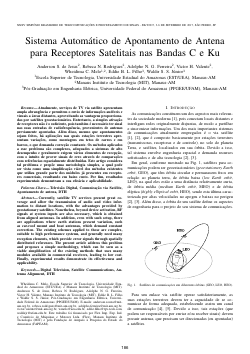
Sistema Automático de Apontamento de Antena para Receptores Satelitais nas Bandas C e Ku
Anderson S. de Jesus, Rebeca N. Rodrigues, Adolpho N. G. Ferreira, Eddie B. L. Filho, Waldir S. S. Júnior, Victor H. Valente, Wheidima C. Melo
DOI: 10.14209/sbrt.2017.34
Keywords: Digital Television Satellite Communications An- tenna Alignment DTH
Abstract
Currently, satellite TV services present great co- verage and allow the transmission of audio and video infor- mation to distant locations, with the advantages provided by geostationary satellites. Nonetheless, beyond device activation, RF signals at system inputs are also necessary, which is obtained from aligned antennas. In addition, even with such setup, there are applications where earth stations present variation, such as car-roof mount and boat antennas, which demand constant correction. The existing schemes applied to those are complex, suitable to high performance systems, and generally need many reception elements, which provide error signals through spatially distributed references. The present article address this problem and proposes a simple methodology, which can be seen as a viable simplification of the existing methods that uses many modules available in commercial receivers, leading to low cost. Finally, experimental results demonstrate its effectiveness and applicability.Download